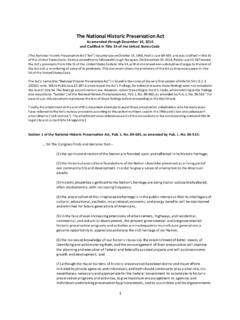Transcription of FACT SHEET: The Build Back Better Act
1 FACT SHEET: The Build Back Better Act Economic stimulus legislation will lower costs, create jobs, fight the climate crisis, and cut taxes for everyday Americans. On November 18, 2021, the House of Representatives passed the Build Back Better Act economic stimulus and job creation legislation that is a key aspect of President Biden s Build Back Better economic agenda. Democrats understand that the deck has been stacked against working Americans. The Build Back Better Act aims to deal them back in. This legislation will help fight inflation and is fully paid for by making big corporations and the wealthy pay their fair share. It keeps President Biden s pledge not to raise taxes on people making under $400,000. As Chair of the House Committee on Transportation and Infrastructure, DeFazio is playing a key role in the drafting and enactment of President Biden s Build Back Better economic agenda. He authored key provisions in the Build Back Better Act that combat the climate crisis and improve the resiliency of our transportation systems and infrastructure.
2 Combined with the recently enacted Infrastructure Investment and Jobs Act - landmark bipartisan infrastructure legislation that Congressman DeFazio played a leading role in getting passed into law - the Build Back Better Act will drive the creation of good-paying jobs and grow the economy sustainably and equitably so that everyone gets ahead for decades to come. Together, these bills will add on average million jobs per year for the next 10 years. Critically, the Build Back Better economic agenda does not increase inflation. In fact, Moody s Investors Service shows that it takes the edge off inflation by supporting long-term economic growth. Congressman DeFazio is committed to leveling the playing field for everyday Oregonians. The Build Back Better Act includes: Life-Changing Investments in Families and Children The lack of affordable childcare is driving parents especially women out of the labor force in record numbers.
3 While many other nations guarantee high-quality, affordable childcare, the has fallen significantly behind. Our childcare shortage has only worsened and working families are suffering. The Build Back Better Act: Lowers childcare costs for working families to help put affordable, high-quality childcare within reach. Establishes free high-quality universal pre-school programs for all three- and four-year-olds. Permanently authorizes the first-ever national paid family and medical leave guarantee for workers, providing up to four weeks of paid leave for parental bonding or to deal with their own or a loved one s serious medical condition. Extends the expanded Child Tax Credit, first enacted in the American Rescue Plan, to make sure nearly 40 million American families covering almost 90 percent of children continue to receive this tax cut. It will also ensure lower-income families are permanently eligible for full benefits, helping to cut child poverty nearly in half.
4 Extends the expanded Earned Income Tax Credit (EITC) to provide relief to millions of low-wage workers, including millions of essential workers. Increases the maximum Pell Grant by $550 for more than 5 million students and expands access to DREAMers. Enhances Home and Community-Based Services with an investment of $150 billion to expand access to quality home-based care for millions of older adults and people with disabilities. This funding includes resources to improve our national care infrastructure by strengthening the direct care workforce. Addresses our nation s urgent housing needs, including the homelessness crisis, by investing $150 billion with targeted resources for new construction and preservation of housing, rental and down payment assistance, sustainable and resilient housing, and fair housing enforcement, among other investments. Invests in workforce development to make it easier for workers to get trained for good-paying jobs to help support their families.
5 These investments will support dislocated workers, help adults train, support youth apprenticeships, and more. Reconnects and revitalizes communities and neighborhoods that were divided by previous highway projects and funds several programs to invest in clean drinking water and wastewater infrastructure in our communities. Invests in connectivity to advance communications technologies and increase access to affordable broadband for low- and middle-income consumers. It also provides additional funding for the Emergency Connectivity Fund so schools and libraries can provide access to internet and connected devices. Provides supply chain investments of $5 billion to safeguard our economy and support domestic job growth. Supports child nutrition by investing $10 billion to expand eligibility and eliminate paperwork so more children can receive free school meals, while also funding a nationwide program to help more children receive healthy nutrition over the summer.
6 Strengthens Trade Adjustment Assistance for workers adversely impacted by competition overseas. Provides State and Local Tax (SALT) deduction relief by increasing and applying the cap over the long-term, allowing states and counties to raise more revenue to deliver essential public services such as emergency response services, public health services, and infrastructure development. Important Step Toward Universal, Affordable Health Coverage Too many Americans are forced to choose between medical care and putting food on the table or affording other necessities. Americans, especially seniors, need Better , affordable access to quality prescription drugs. Millions of people are locked out of Medicaid because of some states refusal to expand the program under the Affordable Care Act (ACA), and health insurance even with premium subsidies is still too expensive for many families. The BBB Act: Lowers the cost of some prescription drugs by allowing Medicare to negotiate lower drug prices, reducing out-of-pocket co-pays, establishing a $35 out-of-pocket maximum for insulin, and creating a new $2,000 out-of-pocket limit for seniors expenses in Medicare Part D, among other important reforms.
7 Extends the expanded ACA Premium Tax Credit, reducing premiums for 9 million Americans. Experts predict that this will help more than 3 million people who would otherwise be uninsured gain health insurance. Closes the Medicaid coverage gap by providing access to health care coverage to 4 million Americans without it who live in states that have locked them out of Medicaid. Reduces out-of-pocket costs by providing enhanced cost-sharing reduction assistance to low-income individuals and creating a new Health Insurance Affordability Fund, which will allow states to establish a reinsurance program or help with reducing out-of-pocket costs. Strengthens Medicaid by expanding access to behavioral and maternal health services, permanently increasing federal funding for territories, and making other program improvements. Makes Investments in Seniors and People with Disabilities by expanding Medicare coverage to include hearing services and hearing aids, investing in nursing home transparency and staffing standards, and bolstering funding for Elder Justice Act programs.
8 Permanently extends the Children s Health Insurance Program (CHIP) to ensure children have continuous access to quality, affordable health insurance, regardless of their family s income. Rebuilds and improves the Department of Veterans Affairs (VA) medical facilities and invests in the VA s health care workforce to deliver 21st-century care to our veterans. History-Making Investments to Tackle the Climate Crisis Protecting our communities and strengthening our resilience in the face of worsening climate-related disasters is vital. The climate crisis is an existential threat that must be handled immediately if we are to avoid the most catastrophic consequences. Postponing action will only endanger more lives and livelihoods as extreme weather events intensify. The Build Back Better Act invests more than $550 billion to deliver the largest effort to combat climate change in American history. The BBB Act: Extends and expands clean energy tax credits to invest more than $300 billion to support clean energy investments and deployment, improve energy efficiency, and encourage vehicle electrification to help combat climate change while creating good-paying jobs that can t be outsourced.
9 Reduces greenhouse gas pollution by providing $29 billion for a new Greenhouse Gas Reduction Fund that will enable nonprofit, state, and local climate finance institutions to leverage private sector investments and rapidly deploy low and zero-emission technologies, including zero-emission vehicle supply equipment, with at least 40 percent of investments in low-income and disadvantaged communities. Accelerates the clean energy transition by funding grants, rebates, and loans to commercialize emerging clean energy technologies, support state and local climate pollution reduction plans, and reduce methane pollution from oil and natural gas operations. Reduces carbon pollution from the transportation sector. Investments include high-speed rail projects that would reduce reliance on higher-emission cars and planes; grant programs to integrate low-carbon materials into transportation projects and develop low-emission aviation fuels and technology; Community Climate Incentive Grants to help states and localities pursue carbon reduction strategies for transportation; and funding for sustainable port infrastructure and supply chain resilience.
10 Drives progress toward widespread zero-emissions vehicle use through $ billion for grants and loans that support domestic auto manufacturing, clean heavy-duty vehicles, and zero-emissions vehicle infrastructure, as well as $9 billion for electrifying the federal and Postal Service vehicle fleets. Lowers energy costs and decreases emissions across homes and factories by investing $19 billion in home energy efficiency and electrification rebates for consumers, advanced technology to reduce emissions in energy-intensive industrial and manufacturing facilities, and new high-capacity transmission lines for reliable delivery of clean energy. Accelerates climate and clean energy research and development, including climate science, weather observation and forecasting, wildfire and hurricane research and climate-smart agricultural innovation and adaptation. Addresses environmental and climate justice by supporting neighborhood equity, safety, and affordable transportation access; economic development for energy and industrial transition communities; community-led projects and capacity-building centers in low-income and disadvantaged areas to address the disproportionate harms of pollution and climate change; and nearly $20 billion for national service and workforce development in support of climate resilience and mitigation projects across the country.


